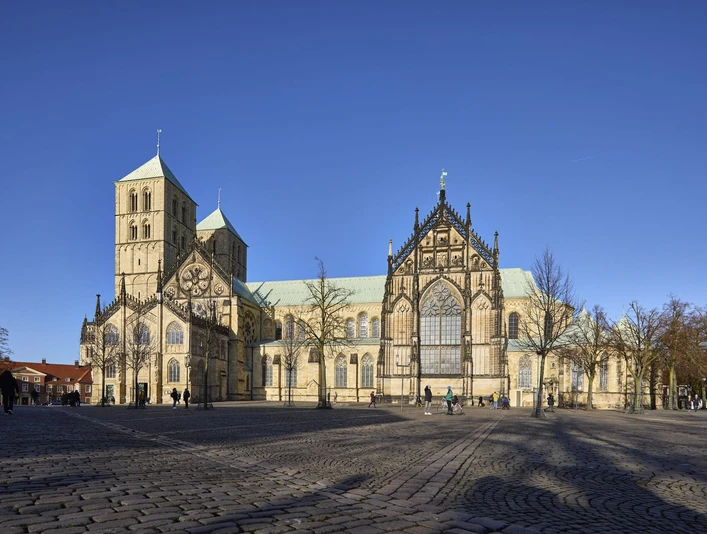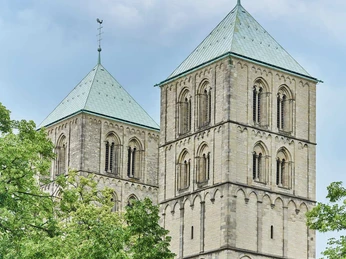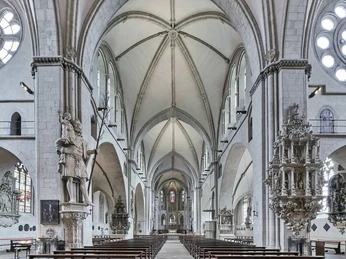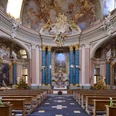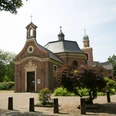The St. Paul's Cathedral in Münster dominates the city centre of Münster due to its size alone. Its 55 metre high towers can be seen from afar. Construction of the current cathedral began in 1192. The history of its predecessor buildings goes back as far as 805.
The Roman Catholic church is located just a few metres from the famous Prinzipalmarkt and the historic town hall and should not be missed on a tour of Münster. A visit to the interior is also highly recommended.
Tour informationOutside of service times, the cathedral administration offers guided tours of Saint Paul's Cathedral. In addition to bookable group tours, barrier-free tours for people in wheelchairs, tours for the hard of hearing and deaf, tours for the blind and visually impaired, and tours in simple language are also offered.
Regular public tours for individuals take place on Saturdays at 1.30 pm. The maximum number of participants is 25.
History informationThe cathedral was built from 1225 to 1265 and consecrated by Bishop Gerhard von der Mark. Its two Romanesque west towers appear almost identical at first glance, but some of them differ significantly in their dimensions. The northern tower is wider and higher than its southern counterpart.
Inside the cathedral is an astronomical clock with a carillon. It is one of the few existing left-turning public clocks. It also shows the phases of the moon and the positions of the planets. Its perpetual calendar extends to the year 2071. Every hour on the hour, a wooden hooter trumpets and its wife rings a bell. Once a day, at noon, metal Magi leave their quarters with two wooden servants and surround a figure of Jesus in the lap of Mary.
The cathedral treasure of St Paul's Cathedral is kept in the cathedral chamber, which was added in 1981. Some of the liturgical objects are still in use today. The exhibition extends over three levels: The lowest level mainly shows historical paraments, while the top level offers a tour through the art-historical epochs to be found at the cathedral by means of selected examples. The middle level shows the most important pieces of the cathedral treasure, including St Paul's head, which dates back to the 11th century, and former furnishing elements of the cathedral, such as a picture cycle by Hermann tom Ring, remains of Brabender's rood screen and a series of monumental reliefs by Gröninger.
The Roman Catholic church is located just a few metres from the famous Prinzipalmarkt and the historic town hall and should not be missed on a tour of Münster. A visit to the interior is also highly recommended.
Tour informationOutside of service times, the cathedral administration offers guided tours of Saint Paul's Cathedral. In addition to bookable group tours, barrier-free tours for people in wheelchairs, tours for the hard of hearing and deaf, tours for the blind and visually impaired, and tours in simple language are also offered.
Regular public tours for individuals take place on Saturdays at 1.30 pm. The maximum number of participants is 25.
History informationThe cathedral was built from 1225 to 1265 and consecrated by Bishop Gerhard von der Mark. Its two Romanesque west towers appear almost identical at first glance, but some of them differ significantly in their dimensions. The northern tower is wider and higher than its southern counterpart.
Inside the cathedral is an astronomical clock with a carillon. It is one of the few existing left-turning public clocks. It also shows the phases of the moon and the positions of the planets. Its perpetual calendar extends to the year 2071. Every hour on the hour, a wooden hooter trumpets and its wife rings a bell. Once a day, at noon, metal Magi leave their quarters with two wooden servants and surround a figure of Jesus in the lap of Mary.
The cathedral treasure of St Paul's Cathedral is kept in the cathedral chamber, which was added in 1981. Some of the liturgical objects are still in use today. The exhibition extends over three levels: The lowest level mainly shows historical paraments, while the top level offers a tour through the art-historical epochs to be found at the cathedral by means of selected examples. The middle level shows the most important pieces of the cathedral treasure, including St Paul's head, which dates back to the 11th century, and former furnishing elements of the cathedral, such as a picture cycle by Hermann tom Ring, remains of Brabender's rood screen and a series of monumental reliefs by Gröninger.
Good to know
Openings
(01.01-31.12) Opening hours
Group tours are available from Monday to Friday 9-12, 13-17 and 18-19 and on Saturdays 9-12 and 13-15.
Group tours are available from Monday to Friday 9-12, 13-17 and 18-19 and on Saturdays 9-12 and 13-15.
Payment methods
Entrance Free
Directions & Parking facilities
Parking
There are other paid parking spaces and multi-storey car parks in the immediate vicinity.
For people with a disabled person's pass, there are nine car parks near the nine car parking spaces near the barrier-free access to the cathedral at the and a further six disabled parking spaces in the area of the post office. available.
Arrival
By bus and train to Domplatz:
It takes about 20 minutes to walk from the railway station to Domplatz. Leave the station in the direction of the city centre and follow the signs to Domplatz.
Bus lines 2, 4, 10, 11, 12, 14 and 22 run from the railway station to the "Domplatz" stop.
By car to Domplatz:
Coming from the south and north: Leave the A1 motorway at the Münster/Nord motorway junction (77) and take the B54 towards Münster. Follow the signs to Domplatz.
Coming from the east: Take the B51 motorway in the direction of Münster. In the city centre, follow the signs to Domplatz.
Coming from the west: Follow the A43 motorway in the direction of Münster, which automatically becomes Weseler Straße. In the city centre, follow the signs to Domplatz.
There are other paid parking spaces and multi-storey car parks in the immediate vicinity.
For people with a disabled person's pass, there are nine car parks near the nine car parking spaces near the barrier-free access to the cathedral at the and a further six disabled parking spaces in the area of the post office. available.
Arrival
By bus and train to Domplatz:
It takes about 20 minutes to walk from the railway station to Domplatz. Leave the station in the direction of the city centre and follow the signs to Domplatz.
Bus lines 2, 4, 10, 11, 12, 14 and 22 run from the railway station to the "Domplatz" stop.
By car to Domplatz:
Coming from the south and north: Leave the A1 motorway at the Münster/Nord motorway junction (77) and take the B54 towards Münster. Follow the signs to Domplatz.
Coming from the east: Take the B51 motorway in the direction of Münster. In the city centre, follow the signs to Domplatz.
Coming from the west: Follow the A43 motorway in the direction of Münster, which automatically becomes Weseler Straße. In the city centre, follow the signs to Domplatz.
More information
Information for cyclists
Münster's old town is surrounded by the so-called Promenade. The cathedral is also easily accessible via this cycle path. The promenade is the "green belt" around the historic old town.
The following themed routes run along the promenade:
100 Castles Route
Peace Route
R1 European Cycle Route
Historic Town Centres Cycle Route
Even more in the mood for cycling? Everyone can find their next cycling tour on the Münsterland cycle path network, which is around 4500 kilometres long.
Münster's old town is surrounded by the so-called Promenade. The cathedral is also easily accessible via this cycle path. The promenade is the "green belt" around the historic old town.
The following themed routes run along the promenade:
100 Castles Route
Peace Route
R1 European Cycle Route
Historic Town Centres Cycle Route
Even more in the mood for cycling? Everyone can find their next cycling tour on the Münsterland cycle path network, which is around 4500 kilometres long.
Contact person
Domverwaltung
Author
Münsterland e.V.
License (master data)
Nearby
